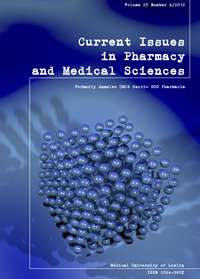Impact of lomefloxacin on antioxidant enzymes activity in normal melanocytes HEMa-LP
DOI:
https://doi.org/10.12923/j.2084-980X/25.4/a.18Keywords:
lomefloxacin, melanocytes, antioxidant enzymesAbstract
Lomefloxacin is a synthetic, broad-spectrum antibacterial antibiotic. The use of this drug in the treatment of various infections may be limited by inherent serious adverse effects on pigmented tissues. The exact mechanisms of lomefloxacin phototoxic side effects have not been well established yet. The aim of this work was to examine the effect of lomefloxacin on antioxidant enzymes activity in cultured human normal melanocytes (HEMa-LP). The demonstrated changes in the activity of antioxidant enzymes (SOD, CAT and GPx) in melanocytes in the presence of lomefloxacin indicate that the analyzed drug is responsible for generation of reactive oxygen species, mainly superoxide anion radical and hydrogen peroxide, what may be the reason of the reduction of melanocytes antioxidant status. Modulation of antioxidant defense system in melanocytes by lomefloxacin in vitro may explain a potential role of melanocytes and ROS in the mechanisms of lomefloxacin phototoxic effects in vivo.
References
1. Bulera S.J. et al.: In vitro phototoxigenic acivity of clinafloxacin: a paradigm predicting photocarcinogenicity Toxicol. Appl. Pharmacol., 156, 222, 1999.
2. Finaud J., Lac G., Filaire E.: Oxidative stress: relationship with exercise and training Sports Med, 36, 327, 2006.
3. Hoogduijn M.J. et al.: Melanin protects melanocytes and keratinocytes against H2O2-induced DNA strand breaks through its ability to bind Ca2+ Exp. Cell Res., 294, 60, 2004.
4. Johnson F., Giulivi C.: Superoxide dismutases and their impact upon human health Mol. Aspects Med., 26, 340, 2005.
5. Jomova K., Valko M.: Advances in metal-induced oxidative stress and human disease Toxicology, 283, 65, 2011.
6. Larsson B.S.: Interaction between chemicals and melanin Pigment Cell Res., 6, 127, 1993.
7. Li Q. et al.: Ofloxacin induces oxidative damage to joint chondrocytes of juvenile rabbits: excessive production of reactive oxygen species, lipid peroxidation and DNA damage Eur. J. Pharmacol., 626, 146, 2010.
8. Mari M. et al.: Redox control of liver function in health and disease Antioxid. Redox Signal., 12, 1295, 2010.
9. Marrot L. et al.: Molecular responses to photogenotoxic stress induced by the antibiotic lomefloxacin in human skin cells: from DNA damage to apoptosis J. Invest. Dermatol., 121, 596, 2003.
10. Neumann N.J. et al.: Evaluation of phototoxic and photoallergic potentials of 13 compounds by different in vitro and in vivo methods J. Photochem. Photobiol. B Biol., 79, 25, 2005.
11. Oliphant C.M., Green G.M.: Quinolones: a comprehensive review Clin. Pharmacol., 65, 455, 2002.
12. Otręba M. et al.: 2012. Regulation of melanogenesis: the role of cAMP and MITF Postepy Hig. Med. Dosw., 66, 33, 2012.
13. Owens R.C., Ambrose P.G.: Antimicrobial safety: focus on fluoroquinolones CID, 41, 144, 2005.
14. Plonka P.M. et al.: What are melanocytes really doing all day long ...? Exp. Dermatol.,18, 799, 2009.
15. Rampal S. et al.: Ofloxacin-associated retinopathy in rabbits: role of oxidative stress Hum. Exp. Toxicol., 27, 409, 2008.
16. Różanowska M. et al.: Free radical scavenging properties of melanin interaction of eu- and pheo-melanin models with reducing and oxidising radicals Free Radic. Biol. Med., 26, 518, 1999.
17. Smith A. et al.: Fluoroquinolones. Place in ocular therapy Drugs, 61, 747, 2001.
18. Thompson A.M.: Ocular toxicity of fluoroquinolones Clin. Experiment. Ophthalmol., 35, 566, 2007.
19. Zhao B. et al.: Detection and prevention of ocular phototoxicity of ciprofloxacin and other fluoroquinolone antibiotics Photochem. Photobiol., 86, 798, 2010.
Downloads
Published
Issue
Section
License
Copyright (c) 2012 Authors

This work is licensed under a Creative Commons Attribution-NonCommercial-NoDerivatives 3.0 Unported License.


